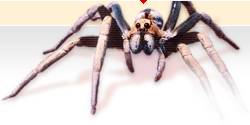
Jumping Spiders
Salticidae Blackwall, 1841
(compiled by Barry Richardson)
Identification
Tiny to large spiders with compact bodies 1-25 mm in length. The eyes are arranged in three (4+2+2) or four (2+2+2+2) rows; the anterior median eyes are much larger than the other pairs and make these spiders immediately identifiable. The cephalothorax is usually rectangular, less frequently oval or elongate. The abdomen is variously shaped, sometimes with dorsal scutes. The spinnerets are terminal or subterminal. Chelicerae are parallel to vertical, the retrolateral margin with one tooth (unidentati), bi/multicuspidate tooth (fissidentati) or multiple teeth (pluridentati). The legs have 2 claws, and vary from short and stout, to very long and thin (up to 4.5 cm long). The first legs usually are more massive than the others while the 3rd or 4th pair are usually the longest. The copulatory organs vary from simple to very complicated, providing good diagnostic characters, though in some distant genera the genitalia may appear very similar.
Biology
Salticids are skilful jumpers that use their superb vision to hunt in daylight. They are often beautifully coloured and, using their excellent vision, males use their colours and dance routines to attract mates. Jumping spiders show highly complex behaviour patterns, for example being able to identify complete and incomplete paths to prey by sight and moving out of sight of prey whilst continuing to stalk them. Some Australian salticid genera (Myrmarachne, Damoetas, Ligonipes, Rhombonotus, Judalana) mimic ants. Others are beetle (Coccorchestes) or fly (Abracadabrella) mimics. Many species may supplement their diet with nectar (Jackson et al. 2001).
Jumping spiders in Australasia
An excellent summary of the general ecology and behaviour of jumping spiders can be found in Forster & Forster (1999). The behaviour of many Australian species has been studied by Robert Jackson and his co-workers. Pictures and drawings of many species can be found in Proszynski (2007) and Nieuwenhuys (2003).
Australia
Jumping spiders are a diverse component of the Australian fauna, with 339 species described and possibly a further 1000 species present. An on-line catalogue (ABRS ABIF catalogue) summarising the available literature on all described species is available (Richardson and Zabka 2003). The family is found in all terrestrial and arboreal habitats throughout Australia and its territories, except the sub-antarctic islands. The fauna is highly endemic, especially in central and western parts of the continent. The salticid faunas of the tropical and coastal habitats of eastern and northern Australia show a strong New Guinean and Oriental influence. Some species are cosmotropical in distribution, one is trans-Pacific and ranges of a few extend to New Caledonia and New Zealand (Zabka 1990, 2002). A key to the genera of the wetter parts of Australia is available (Davies and Zabka 1988).
New Zealand
A general introduction to the jumping spiders of New Zealand can be found in Forster and Forster (1999). The biogeography of the New Zealand fauna is summarised in Zabka (2002).
References
Forster, R. & Forster, L. (1999). Spiders of New Zealand and their Worldwide Kin. Otago: University of Otago Press
Forster, R. & Forster, L. (1999). Spiders of New Zealand and their Worldwide Kin. Otago: University of Otago Press
Jackson, R.R., Pollard, S.D., Nelson, X.J, Edwards, G.B. & Barrion, A.T. (2001). Jumping spiders (Araneae : Salticidae) that feed on nectar. J. Zool. (Lond.) 255: 25–29
Nieuwenhuys, E (2003). Salticidae of Australia.
Proszynski, J. (2007). Salticidae (Araneae) of the World (Version 2007).
Richardson, B.J. and Zabka. M (2003). Salticidae. Australian Faunal Directory, Arachnida: Araneomorphae. Canberra.
Zabka, M. (1990). Remarks on Salticidae (Araneae) of Australia. Acta Zool. Fenn. 190: 415–418
Zabka, M. (2002). Zoogeography of Salticidae (Arachnida : Araneae) of New Zealand. Ann. Zool. (Warsaw) 52: 459–464

